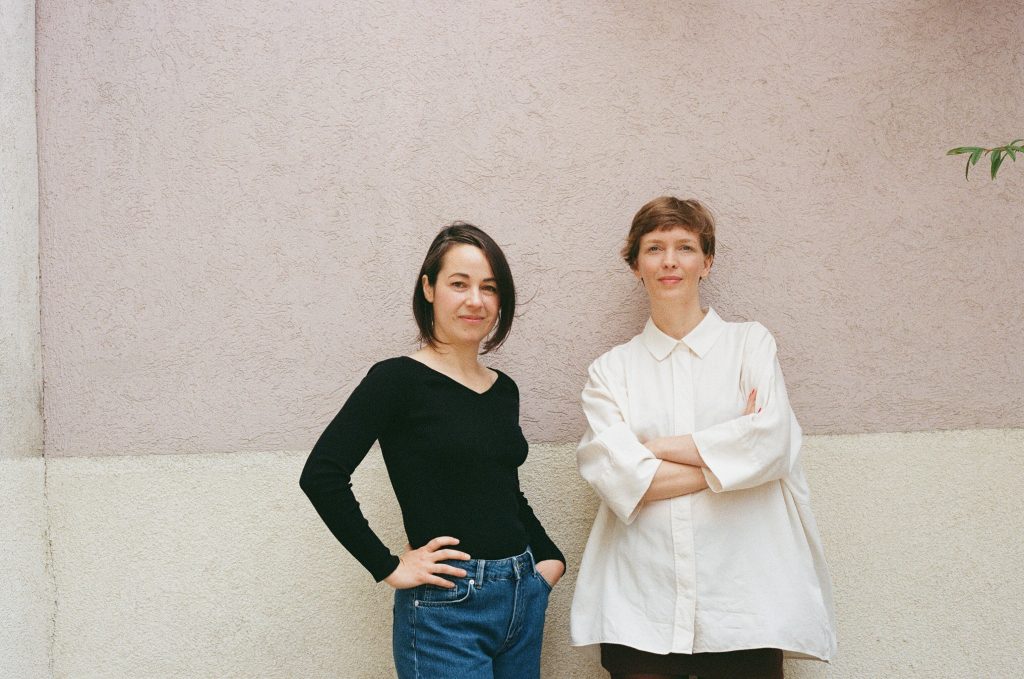This year’s Science Ball has a fresh new look. A visit with the designers who created the new poster.
Portrait by Flora Neubert
The office is bright and tidy, books on design are stacked high – sources of inspiration. The poster on the wall already hints at what we’re here for: We’re visiting art directors and graphic designers Anna Hazod and Isabella Schlagintweit. The former focuses on illustrations, the latter on typography. The two have been working together for more than ten years, and since 2020 they’ve run their own design studio, Hazod Schlagintweit.
With their book “Salt,” they made a name for themselves in the Austrian design scene – and were promptly awarded the title of “Austria’s Most Beautiful Book” for their design. This non-commercial publication is what they call their “passion project.” Redesigns are one of their specialties. For example, for Drahtesel, the Austrian cycling magazine. What’s simply indispensable to their work? Constantly exchanging ideas. The concept is bearing fruit: not only are impressive publications the result, but also a relationship of trust they can rely on. They set their own parameters: “That’s a good thing. Within such boundaries, you can explore new possibilities for the coming years,” emphasizes Anna Hazod. “We always try to be positive and honest.” Isa Schlagintweit adds: “Above all, honest.”
Translating complex topics into a simple visual language is Anna Hazod’s specialty. “The opportunity lies in representing diversity and finding new paths.” But how can science be depicted visually? “Illustrating things concretely isn’t really appropriate here. Working abstractly was the solution.”
In the spirit of diversity
In recent years, dance couples adorned the poster and cover of the ball magazine. This year, a kaleidoscope takes its place. Patented in 1817 by Sir David Brewster, the kaleidoscope originally served as a scientific instrument in the 19th century for studying light reflections. Today, it is primarily known as a children’s toy, but it has lost none of its fascination. A glance through the kaleidoscope reveals new worlds: colorful and varied shapes can easily be created through light reflections.
Schlagintweit and Hazod designed it according to the principle of “less is more.” This is also evident in the minimalist illustration, which nevertheless doesn’t lack splendor and festivity. Colorful triangles create a vibrant interplay of colors. Whether kaleidoscope, ball gown, or cell division: what one can discern in Anna’s illustration, true to her motto, knows almost no bounds. “The kaleidoscope is a good means of expressing the diversity and richness in science and research, which the ball symbolizes. At the same time, the illustration looks incredibly festive and sparkling,” adds Schlagintweit. The kaleidoscope as a symbol of diversity – speaking of which: How can illustration and typography break down barriers?
Giving science a fresh look
A clear design language is one thing. But the choice of typeface can also break down barriers. Baskerville has been replaced by Edict, designed by the Berlin-based type studio schick toikka. “Baskerville stands for science, research, and seriousness. It’s used in papers. I was looking for a typeface that meets these criteria but is more modern,” explains Schlagintweit. The serifs of Baskerville are retained in Edict. But the typeface is given a new, modern look. “The corporate identity, or visual identity, is quite understated and provides a framework for the illustration, which will change every year, giving it plenty of room to breathe,” explains Hazod.
The design agency Hazod Schlagintweit frequently collaborates with cultural and scientific organizations. With the new corporate identity, the designers have created a future-proof concept that will accompany the ball and its guests for years to come. Sustainability – that’s also embodied in the new design. But a ball is new territory for them, as Hazod reveals: “We’re not big ball-goers yet. But we thought: if we’re going to a ball, then it has to be the Science Ball. We think it’s great that Austria is being strengthened as a research location.”
